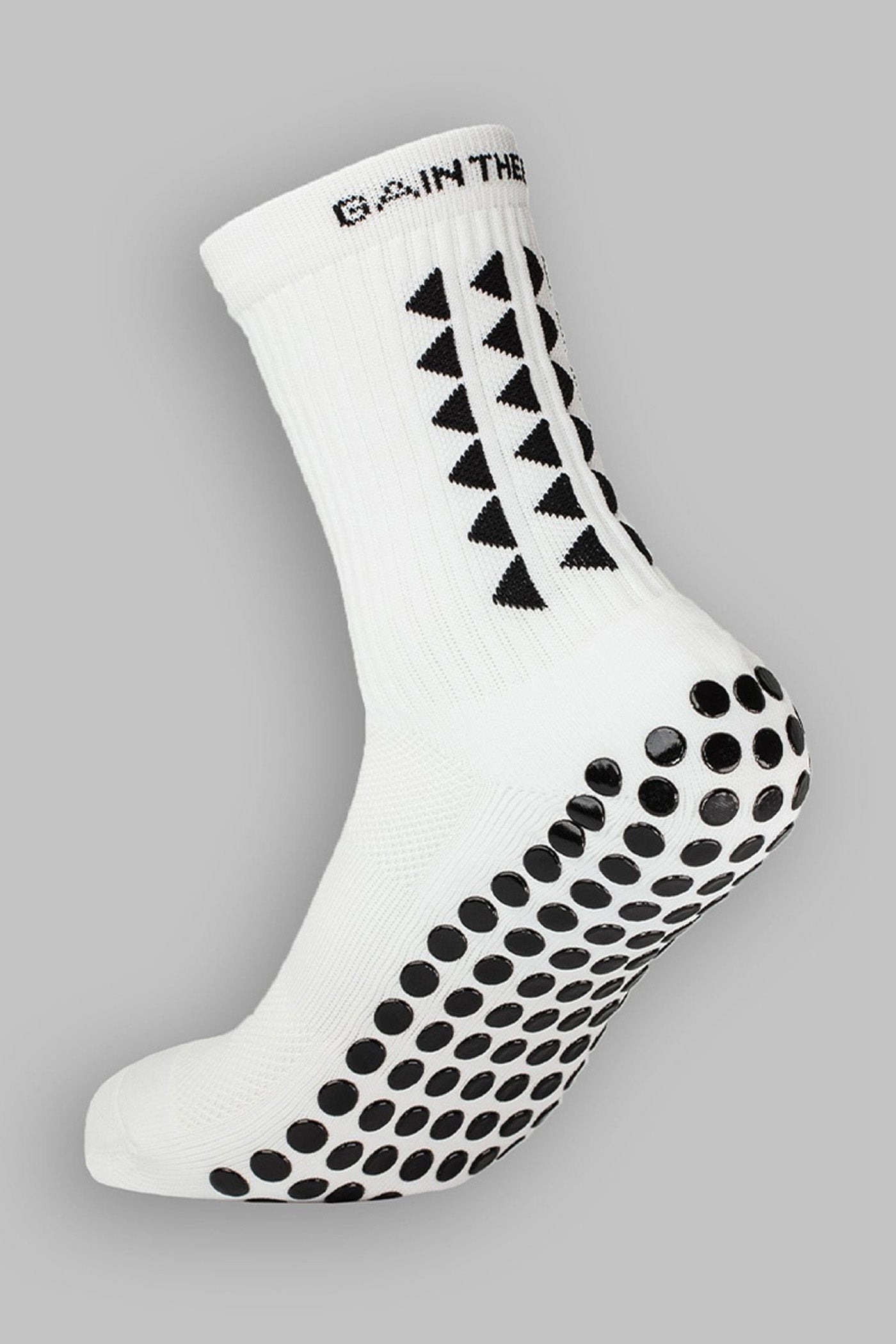Although compression socks have their origin in the medical field, they’re used across different sports and fitness activities today.
But what about compression socks for runners? Do they have any specific benefits?
Well, that’s exactly what we’re going to discuss. In this article, we’ll discuss the various benefits of compression socks for runners, as well as how to choose the best compression socks for you so that you can reap the full performance benefits of these handy inventions.
What this article covers:
- Benefits of Compression Socks for Running
- How to Choose the Best Compression Socks for Running
- Compression Socks for Runners (FAQs)
Benefits of Compression Socks for Running
Compression Sock Benefits
Increased Circulation
During running, the muscles in the legs constantly contract and relax, which can restrict blood flow and lead to the accumulation of metabolic waste products such as lactic acid. Compression socks can help counteract this by applying pressure to the veins and muscles in the lower legs.
Pressure can help improve blood flow and reduce the buildup of waste products. Increased circulation helps deliver more oxygen and nutrients to the muscles, allowing them to work more efficiently and for extended periods.
Compression socks can be particularly beneficial for runners because they can help prevent blood pooling in the lower legs and feet, which can occur due to the repetitive impact of running.
Reduced Muscle Fatigue
Muscle vibration during running is natural when your foot strikes the ground, and your muscles contract and relax in response to the impact.
While some muscle vibration is normal during running, excessive vibration can lead to muscle fatigue and injury over time. This is especially true if you are running on hard or uneven surfaces. Hard surfaces can amplify the shock and vibration that your muscles experience.
Compression socks can help reduce muscle fatigue and soreness by supporting the calf muscles. Calf muscle support minimizes the vibration of the muscles during running, which can lead to micro-tears and soreness. The compression also helps to stabilize the muscles, reducing the risk of muscle strain or injury.
Injury Prevention
Several factors can cause injury in a runner's legs. Running too frequently, too long, or too hard without adequate rest and recovery can cause stress and strain on the muscles, tendons, and bones.
Running with poor form or incorrect posture can put excessive stress on specific areas of the legs, leading to injuries such as shin splints, patellofemoral pain syndrome, and IT band syndrome.
Compression socks can help prevent injuries such as shin splints, Achilles tendonitis, and plantar fasciitis by providing extra support to the muscles and tendons in the lower leg. These conditions are often caused by overuse or repetitive stress on the muscles and tendons. Compression socks can help reduce this stress by providing extra support.
Faster Recovery
Compression socks can help prevent lactic acid buildup in your muscles. After a run, the muscles in the legs can be inflamed and sore due to the buildup of metabolic waste products. Lactic acid is a byproduct of exercise that can contribute to muscle soreness and fatigue.
Compression socks can help speed recovery by increasing blood flow to your muscles and flushing out these waste products.
Compression socks can also help improve muscle recovery after exercise by reducing inflammation and swelling in the legs. This can help reduce muscle soreness and stiffness and improve range of motion, which can help athletes return to training more quickly.
Improved Performance
Some studies have shown that wearing compression socks during exercise can improve running performance, particularly in endurance events.
Compression socks help reduce muscle fatigue during exercise by improving blood flow. When tired, muscles can become sore and achy, limiting performance.
Compression socks can provide support and stability to the lower leg, which can help improve proprioception - the body's sense of position and movement in space.
Enhanced proprioception can help athletes maintain better balance and stability during physical activity, which can help reduce the risk of injury. Socks with grips on the bottom help prevent the feet from sliding inside the shoes during high-intensity workouts. This can be particularly helpful for runners and other athletes who need stability and balance.
How to Choose the Best Compression Socks for Running
Compression Level
Compression socks come in different compression levels, usually measured in mmHg (millimeters of mercury). Look for socks with a compression level of 15-20 mmHg or 20-30 mmHg for running.
Mild compression socks are suitable for runners who want to prevent swelling, muscle fatigue, and soreness during and after running. We recommend moderate compression socks for runners who are at risk of developing varicose veins or have mild swelling. Both pressure levels can help improve endurance, reduce muscle fatigue, and speed up recovery.
Material
Choose compression socks made from breathable and moisture-wicking materials. Socks made from nylon, spandex, or polyester are the best wicking socks for running. Moisture-wicking is the ability of a material to pull moisture away from the skin and move it to the outer surface of the fabric, where it can evaporate more efficiently.
Moisture-wicking technology is often incorporated into compression socks to help prevent sweat and odor buildup. Keeping your feet dry helps reduce the risk of blisters and other foot irritations.
Size
Make sure you choose the right compression socks size to ensure maximum effectiveness. There is no universal standard sizing for compression socks.
Use a tape measure to measure the circumference of your calf at its widest point. Make sure to measure both calves since they may be different sizes.
Compression sock manufacturers typically provide a size chart that correlates calf circumference with the appropriate sock size. Choose the proper size compression sock based on your calf circumference and the size chart. Following the manufacturer's recommendations is essential since sizing can vary between brands.
Design
When choosing compression socks for running, several key design features make the best socks for runners. Compression socks designed specifically for running often have extra cushioning in high-impact areas.
Running can put a lot of stress on your feet, so choosing compression socks that provide adequate padding in the right places is essential. Look for socks with extra cushioning in the heel and ball of the foot. For example, our dark blue grip socks will boost your stability while cushioning your foot from hard surfaces.
Compression socks for running should provide adequate arch support to reduce foot fatigue, prevent excessive foot pronation and minimize the risk of injury. Look for socks that have built-in arch support or that are designed with a supportive band across the arch.
A seamless design will prevent chaffing from your socks. Seamless socks do not have any seams that can irritate or rub against the foot, causing discomfort. They provide a smooth and snug fit that can help to reduce pressure points, blisters, and other skin irritations.
Seamless socks make the best ladies running socks. They are designed to fit the foot's contours more closely than traditional socks, providing a better fit and reducing the likelihood of slipping or bunching.
Conclusion
So do running socks make a difference? While compression socks may benefit specific runners, they don’t eliminate the need for proper rest, hydration, and nutrition for optimal performance and recovery.
Research agrees that compression socks can be helpful with post-run recovery. Still, they must be at the correct compression level and correctly fitted. Studies on performance enhancement are, however, mixed.
Compression socks can be a great addition to your running gear. Compression socks keep your legs warm during cold running days and protect your legs from cuts, scratches, and dirt on trail runs.
Compression Socks for Runners (FAQs)
What Are Compression Socks?
Compression socks are socks or stockings designed to improve blood circulation in the legs and feet. They apply pressure to the lower legs, ankles, and feet, which helps to support the veins and increase blood flow back to the heart.
Compression socks are typically made of stretchy materials, such as spandex or nylon, that provide a tight fit around the legs. The compression level can vary, with some socks offering mild compression and others offering more firm compression.
Mild compression socks typically have a pressure of 8-15 mmHg, while firm compression socks have a pressure of 20-30 mmHg or more.
Compression socks are available in various styles and colors. You can purchase compression socks over the counter or with a prescription from a healthcare provider.
How Do Compression Socks Work?
Compression socks are designed to apply pressure to the lower legs, ankles, and feet. They work by improving blood flow and reducing swelling in the lower limbs. People on their feet often use compression socks for extended periods, such as athletes, pregnant women, and people with circulation issues or varicose veins.
Compression socks use graduated compression, which means the pressure is strongest at the ankle and gradually decreases as it goes up the leg. This helps push blood back toward the heart, improving circulation and reducing blood pooling in the legs.
When you run, your muscles require more oxygen, so your heart pumps more blood to your legs. This increased blood flow can cause your blood vessels to expand, leading to swelling.
The pressure applied by compression socks helps to reduce swelling by preventing fluids from accumulating in the tissues. This can help to alleviate discomfort and prevent the development of more severe conditions such as deep vein thrombosis (DVT).
Did our blog meet your needs? You might also find our other guides helpful:
- How Long Does It Take for Compression Socks to Work?
- Wearing Compression Socks Too long
- Can You Wear Compression Socks All Day?
- How to Wear Compression Socks
- Compression Socks vs Sleeves
- Easy to Put on Compression Socks for Elderly
- Socks as Gifts
- Best Sock Material
- What Do Grip Socks Do?
- What Are Ankle Socks?
- How to Wear Grip Socks
- Best Compression Socks
- How Long to Wear Compression Socks for
- Best Walking Socks
- Best Walking Socks (Women's)




















